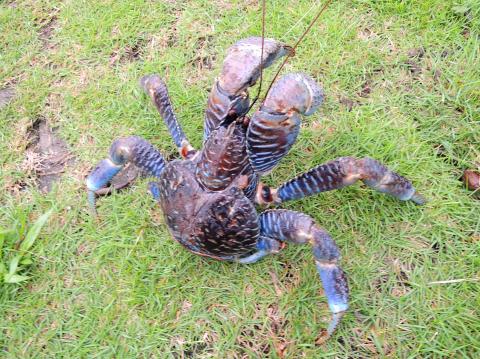A Hualien homeowner has discovered a critically endangered coconut crab crawling along a bank of the Meilun River (美崙溪). Not a single member of this species had been seen in the upper east coast region for many years.
A resident, surnamed Wu (吳), whose home is near the river in the city, said that he found a female coconut crab in his backyard on Wednesday last week.
“I was out feeding the fish in my backyard pond. This strange creature came crawling near my feet. I had no idea what it was, so I took a photograph of it,” Wu said.

Photo: Wang Chin-i, Taipei Times
“I posted the picture with a message to a friend, who had some background in biology, thinking he might be able to help to identify it. To my surprise, he said it was a coconut crab, an endangered species in Taiwan,” Wu said.
He contacted Hualien County’s Bureau of Agriculture conservation office, seeking its help in releasing the crab so it could propagate.
Conservation officer Lin Cheng-ko (林政科) was sent to Wu’s home to examine the coconut crab, which has distinct dark purple and blue colors on its exoskeleton.
Lin said that the crab was a healthy and energetic female.
He was elated to find she was carrying a lot of eggs in her brood sac on her underbelly.
Ho Ping-ho (何平合), assistant professor at National Taiwan Ocean University and a marine crustacean specialist, said it was the first time a live coconut crab has been found in the Hualien area in more than a decade.
“It could be an important find if this female crab is a native inhabitant. She may have lived along Hualien’s seashore and crawled her way from there up the Meilun River. If so, we may have a healthy population of coconut crabs around here, and this would be very exciting news,” he said.
However, he said there was another possibility.
“This particular crab may have escaped from someone who is illegally importing and raising such crabs,” he said.
“It is also possible this female crab ‘got lost’ on her oceanic journey and found her way to Taiwan’s east coast. Summer is the breeding season for coconut crabs. The female heads to the seashore to burrow and lay eggs. At times, they may be washed out to sea, then ride the ocean current to land in Taiwan,” Ho said.
If that is what happened, then it is likely the crab came from the Philippines or other islands to the south, and was carried north by the Kuroshio Current, he said.
Coconut crabs (Birgus latro) are a species of terrestrial hermit crab, and are widely distributed along tropical and subtropical islands in the Western Pacific Ocean.
“However, due to human predation and habitat destruction, coconut crabs are extinct in most areas of Taiwan,” Ho said.
They are also disappearing in other countries, and are listed as a critically endangered species under international wildlife conservation conventions.
“It is the only crustacean species listed under protection in Taiwan. These days it can only be found on Green Island (綠島) and Lanyu (蘭嶼), and some areas on the coast of Taitung County,” Ho said.

The brilliant blue waters, thick foliage and bucolic atmosphere on this seemingly idyllic archipelago deep in the Pacific Ocean belie the key role it now plays in a titanic geopolitical struggle. Palau is again on the front line as China, and the US and its allies prepare their forces in an intensifying contest for control over the Asia-Pacific region. The democratic nation of just 17,000 people hosts US-controlled airstrips and soon-to-be-completed radar installations that the US military describes as “critical” to monitoring vast swathes of water and airspace. It is also a key piece of the second island chain, a string of

A magnitude 5.9 earthquake that struck about 33km off the coast of Hualien City was the "main shock" in a series of quakes in the area, with aftershocks expected over the next three days, the Central Weather Administration (CWA) said yesterday. Prior to the magnitude 5.9 quake shaking most of Taiwan at 6:53pm yesterday, six other earthquakes stronger than a magnitude of 4, starting with a magnitude 5.5 quake at 6:09pm, occurred in the area. CWA Seismological Center Director Wu Chien-fu (吳健富) confirmed that the quakes were all part of the same series and that the magnitude 5.5 temblor was

The Central Weather Administration has issued a heat alert for southeastern Taiwan, warning of temperatures as high as 36°C today, while alerting some coastal areas of strong winds later in the day. Kaohsiung’s Neimen District (內門) and Pingtung County’s Neipu Township (內埔) are under an orange heat alert, which warns of temperatures as high as 36°C for three consecutive days, the CWA said, citing southwest winds. The heat would also extend to Tainan’s Nansi (楠西) and Yujing (玉井) districts, as well as Pingtung’s Gaoshu (高樹), Yanpu (鹽埔) and Majia (瑪家) townships, it said, forecasting highs of up to 36°C in those areas

IN FULL SWING: Recall drives against lawmakers in Hualien, Taoyuan and Hsinchu have reached the second-stage threshold, the campaigners said Campaigners in a recall petition against Chinese Nationalist Party (KMT) Legislator Yen Kuan-heng (顏寬恒) in Taichung yesterday said their signature target is within sight, and that they need a big push to collect about 500 more signatures from locals to reach the second-stage threshold. Recall campaigns against KMT lawmakers Johnny Chiang (江啟臣), Yang Chiung-ying (楊瓊瓔) and Lo Ting-wei (羅廷瑋) are also close to the 10 percent threshold, and campaigners are mounting a final push this week. They need about 800 signatures against Chiang and about 2,000 against Yang. Campaigners seeking to recall Lo said they had reached the threshold figure over the